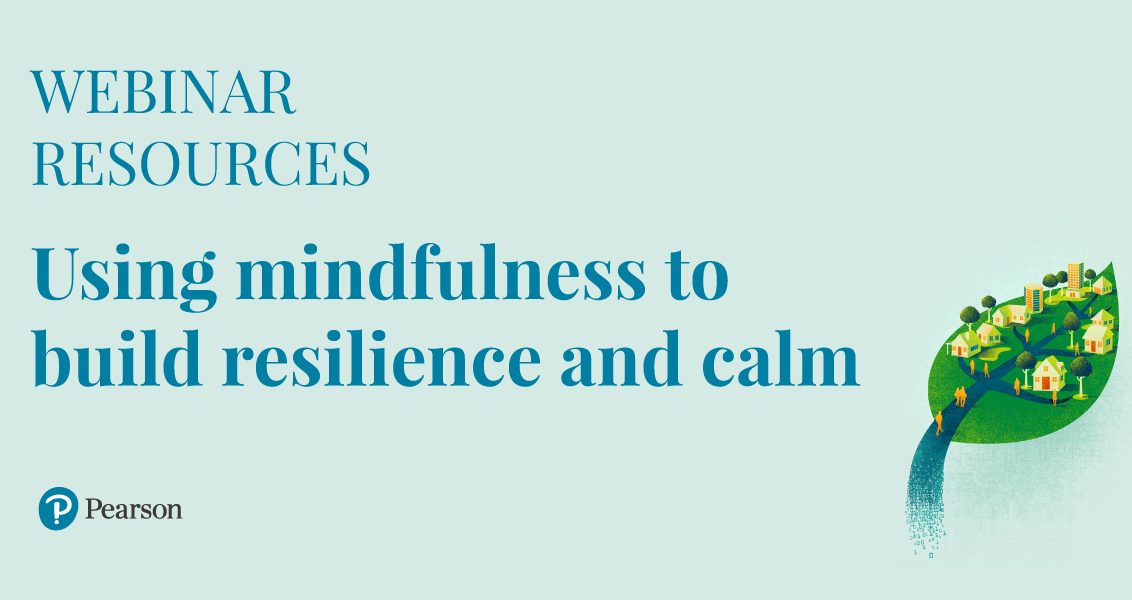
Mindfulness is definitely ‘a thing’ in education! Over 1000 people registered for our mindfulness webinars – AND you asked to learn more about it. Here are the answers plus resources for your classroom!
Thank you so much to those of you who joined us for one of our webinar sessions on Using Mindfulness to Build Resilience and Calm in the Classroom this week. Those of you who were unable to join the sessions live can now watch the webinar recording below.
FAQs – you asked, we answer!
Before you start reading the FAQs, here are the extra resources we mentioned in the webinar:
- Guided meditation for use with younger students
- Guided meditation for use with older students
- Guided meditation for teachers’ own use
- A summary handout
- Webinar slides
How long should we practise for and how often?
Mindfulness meditation is to the brain like physical exercise is to the muscles: regular practice builds up strength in order to feel the benefits. If you can, maybe try introducing 2-5 mins of the breathing practice we’ve shared into the classroom pre-registration or after break/lunch, and building up to a little longer as they get used to it and if there is time. For older students, there could be a mindfulness club at lunchtime or before school. Once is great. A couple of times a week is brilliant. Daily is even better. It’s important that it doesn’t feel like a chore either for you or for the students.
In terms of how long to practice before you might start noticing benefits, it can greatly depend on the individual students and the context. Most academic studies centre around evaluating the impact of 8-week programmes so most of the statistics are based on a regular practice over 8 weeks. However, some notice a difference in even a couple of weeks, so I’d love to hear more about your experiences of implementing it already, and how long before you noticed a shift in behaviour and mood of your students. We are building a practice tool for life here, so this is just the start of that journey and the benefits will build and grow over time.
When should we start introducing it?
The sooner the better really. Choose a time that works for your school and your students. In high school contexts, they may find starting to learn these skills helpful in advance of busy exam terms, in preparation for this more pressurised period. It takes time for the effects of a regular mindfulness practice to bed in, so whilst interventions of breathing actually during the stressful period are really valuable, it can be even more valuable to start practising in advance of that period so that they have built up some ‘muscle memory’ in the mind.
What about disruptive students?
Students who don’t want to take part
Again, it’s important not to create pressure around the practice. Try making it clear that they don’t have to take part, but that you’d like them to at least a go to see what it’s like. If they really don’t want to, ask them to sit quietly doing an activity or reading while the others take part. Sometimes there are high spirits, particularly when younger primary age children are presented with a novel activity, so it can take some time to settle down. Eventually they will though. If they don’t, see the next section!
Students who don’t want to close their eyes
That’s absolutely fine – some adults are uncomfortable with this too and it can feel a bit vulnerable for some. So it’s fine to keep the eyes open – ask them to gaze gently down the end of their nose with a soft focus so that they stay within their own space, but do not necessarily need to close their eyes.
Students who are actively disrupting others
Whether you want them to take part or not rests with your discretion. Interestingly, however, it is often the more restless children who may be most in need of learning this skill! Ingrid Slack and David Fontana, authors of How to Teach Meditation to Children have some great advice here which has moulded my practice in this context, and I have noticed the same so I’ll defer to them:
“If a disruptive child does not respond to your firm but gentle efforts to ask him or her to sit quietly, a very effective strategy is that of self-controlled exclusion.” The technique is to direct the disruptive child to another part of the room and say that they can either sit there quietly, or rejoin the group when they are ready, but that they are disturbing others who want to take part so they need to sit aside. It is important to frame it as protecting the group activity, rather than a rejection of the child.
If this continues, you can send them out of the room, gently but firmly, with the same couching that it is to protect others wanting to take part, and that they are more than welcome to come and join in when they are ready to do so quietly. If they do, welcome them with pleasure back to the circle and carry on from where you were. Slack and Fontana explain, “you are allowing the children to retain their personal power and take responsibility for themselves. They have complete control over whether to sit in the group or to face the wall. This avoids feelings of rejection, and helps children to develop a sense of responsibility towards others. Treated in this way, children are able to recognise the effects of their actions and realize their own efficacy.” (Fontana & Slack (2007) p137).
Students who are faking meditation
As long as they are not disrupting others, this is ok. At least they are taking part and eventually they should settle into it genuinely.
Using mindfulness with SEN students, mental health conditions & hyperactivity, including any potential negative impact?
The calming and emotional regulatory benefits of mindfulness are wide-reaching, but the research into impact on more vulnerable populations is still ongoing. We are talking about very low-intensity mindfulness practices here – just focusing on the breath for a short period, acknowledging the passing of thoughts, and on mindful living activities such as mindful eating, mindful walking. These are safe practices due to their low intensity and have been developed with safeguarding of the participant in mind.
Moderate-intensity practices such as intense thought observation or high-intensity practices such as retreats which ask participants to sit in silent contemplation for long periods of time tend to be those in studies which may demonstrate negative impact on the participant.
For students with severe anxiety, schizophrenia or Borderline Personality Disorder, ASD or ADHD, or any other formally registered condition, it is strongly advised to talk to their medical or therapeutic professional before introducing mindfulness practices with them.
Ideas for younger learners?
Anything that you can do to keep it playful and fun, whilst still calm, is great. The track we will share for younger students has the concept of a little soldier watching the breath with them at the nose, and then marching down to their tummy and watching it move up and down. You can try this with a teddy bear too – getting the children to rest their favourite teddy on their tummy and watch it move up and down.
Mindful eating is lovely to explore too – eating a raisin or grape slowly and exploring it with all of the senses one at a time.
You might find that playing some calming music and asking them to lie down or sit quietly and listen to the song and watch their tummy rise as they breathe is something which works well too.
Ideas for high school students?
The techniques of counting and following the breath are really helpful for high school students – any low-intensity breathing practice like this, followed by discussion, is really helpful to foster calm by slowing down the breathing. Have a go with the tracks we’ve shared. Older students may be able to sit for longer than 5 minutes and focus.
PE classes for 4 year olds – is this a good time to try it?
Movement and stillness are lovely to combine and sometimes either having a period of settling at the start or positioning it as a closing activity before going back to class works really well. So yes!
What about large groups (30+)?
It depends on the context. If you are holding a mindfulness club, you may wish to invite smaller groups along. If you are doing it in a classroom context, then it’s fine in larger groups, being aware of the potential need for some patient, gentle and firm behaviour management for some more fidgety or disruptive students while they get used to this new part of their routine.
Communicating about mindfulness with parents
Communication of anything new is key. For parents from a particularly religious background, it can be helpful to emphasise the secular nature of the activities and present some of the academic and anecdotal evidence to them when communicating about it. We’ve touched on some of this in the webinar and the previous blog series, but please do get in touch if you’d like more signposting about this. In particular, the Mindfulness In Schools project has some great further reading to support this.
You may also wish to include some key notes on the benefits and exercises you are practising in a newsletter or parents’ evening. Another approach is an opt-in mindfulness club at lunch, break or after school to gather early interest and gather some of your own anecdotal evidence in support of practising mindfulness. This can then be used to support communication around a wider roll-out.
Useful websites & apps
Oxford Mindfulness Centre
Mindfulness in Schools Project (guidelines around teacher training and further ideas for the classroom)
Headspace (ground-breaking free meditation app with premium content around mindfulness for kids and for families, and useful reading)
Cosmic Kids (Yoga and Mindfulness videos for children)
Smiling Mind (a lovely app from Australia with mindfulness for younger minds)
About the author
Amy Malloy is a freelance writer and editor, and the founder of No More Shoulds.com, teaching mindfulness for healthier, kinder minds. With 15 years’ experience in teaching and educational publishing, she now combines first-hand understanding with wellbeing practices to help educators and students find inner calm in a stressful world.

